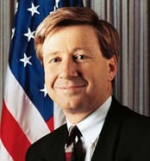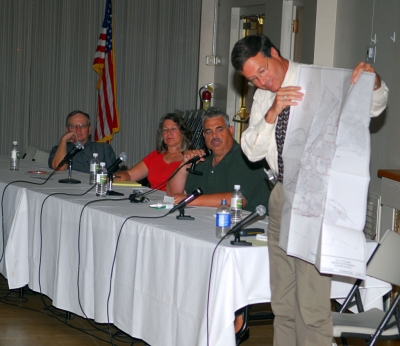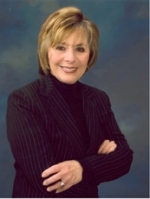|
By Anonymous — Wednesday, August 13th, 2008
VENTURA COUNTY, CA, August 6, 2008 – Interested Ventura County residents are cordially invited to attend a McCain Nation Party on Thursday, August 14th at 6 p.m. at the Ventura County Republican Center located at 2219 E. Thousand Oaks Blvd., Suite 103, Thousand Oaks (across from “The Lakes”). The event will allow individuals the opportunity to learn about John McCain’s agenda for America and learn what they can do to help John McCain win in November. Please join the Ventura County Republican Party for this important and fun event. Admission is free and refreshments will be served. To RSVP, please contact Natalie Panossian at venturacountygop@gmail.com or by calling (805) 217-2465. |
Now Hiring: Deputy City Clerk
The City of Fillmore is seeking a detail-oriented and highly organized professional to join our City Clerk’s Office as Deputy City Clerk. This key role supports City Council operations, maintains official records, ensures legal compliance, and helps uphold transparency in local government. If you’re passionate about public service, governance, and supporting elected officials, we encourage you to apply. Learn more and apply at www.fillmoreca.gov.
|
By Anonymous — Thursday, August 7th, 2008
FILLMORE CITY COUNCIL -AND- FILLMORE REDEVELOPMENT AGENCY IF YOU WISH TO SPEAK: Oral Communications is the time for citizen presentations or comments on items not on the agenda, but within the responsibility of the City Council. Please complete an Audience Participation Form prior to the beginning of oral communications and hand it to the clerk if you wish to speak. Please stay within the time limit indicated by the Mayor. If you wish to speak on an item on this agenda, please fill out an Audience Participation Form and hand it to the clerk prior to that item. AUDIBLE DEVICES: Please ensure all audible devices (pagers, telephones, etc.) are off or otherwise not audible when the Council is in session. Thank you. AGENDA TIMES: Please note the time listed for each agenda item is the suggested/estimated time for that item to begin. Items may be heard earlier or later than the listed time. The estimation includes providing an occasional 10-minute break. No new business will be considered by the City Council after 11:30 p.m. unless a majority of the Council determines to continue. MEMORANDUMS: Memorandums relating to agenda items are on file in the Administrative Assistant's Office. If you have questions regarding the agenda you may call City Hall at (805) 524-3701 or come to City Hall for information. Materials related to an item on this agenda submitted to the City Council after distribution of the agenda packet are available for public inspection in the Administrative Assistant's office at City Hall during normal business hours. Such documents are also available on the City of Fillmore's website at www.fillmoreca.com subject to staffs ability to post the documents before the meeting. REPLAY SCHEDULE: City Council meetings will re-broadcast on Channel 10 on Wednesdays at 10 a.m., Saturdays at 10 a.m., and Sundays at 6 p.m. CITY COUNCIL AND REDEVELOPMENT AGENCY AGENDAS ARE POSTED AT: http://www.fillmoreca.com/doc_download.htm ITEM___________________________________________REFERENCE** 1. CALL TO ORDER & PLEDGE OF ALLEGIANCE " Oral 4. CITY COUNCIL CONSENT CALENDAR (6:40p) 4A. Warrant List for August 7, 2008. Copy 5. REDEVELOPMENT AGENCY CONSENT CALENDAR 5A. Warrant List for August 7, 2008. Copy City Manager Public Works Director 10. CITY COUNCIL REPORTS, DISCUSSION AND APPOINTMENTS 11. CITY COUNCIL EXECUTIVE SESSION 11B. Conference with Real Property Negotiators (Gov't Code Section 54956.8); Property; 12. ADJOURNMENT- City Council adjourns to a regular meeting set for Tuesday, August 26, 2008 at 6:30 p.m. at Fillmore City Hall, 250 Central Avenue, Fillmore, California.______(9:00p) PLEASE NOTE: If you challenge the actions of the City Council in court, you may be limited to raising only those issues you or someone else raised at the public hearing described in the public notice, or in written correspondence delivered to the City Council at, or prior to, the public hearing. (Calif. Gov't Code §65009). For the complete agenda, click on the link below. |
|
By George Runner — Wednesday, August 6th, 2008
National Night Out Gives Americans a Fighting Chance against Crime
 Senator George Runner Serving the 17th District which incorporates portions of the Los Angeles, San Bernardino, Ventura and Kern counties. The men and women of law enforcement have an important job. But when communities get involved, it helps them better protect our neighborhoods, streets and schools. That’s where National Night Out comes in. Created in 1983, National Night Out brings neighbors together throughout the country to fight crime. The program heightens awareness of crime prevention and improves relationships between police and the community. It gives power to the people. It gives them a collective voice. People aren’t just talking about fighting crime; they’re doing something about it. Tuesday, Aug. 5 marks the 25th anniversary of the national event. On this evening, 34 million people in 10,000 communities nationwide will celebrate National Night Out. Some of the cities and counties that I represent in Senate District 17 will participate – Lancaster, Palmdale (held tonight beginning at 5:30 p.m.), Victorville, Hesperia and Santa Clarita. In these neighborhoods, organizers put together barbecues and children’s activities. Costumed characters entertain the kids. Local police officers introduce themselves, putting a face to a badge, and inform the community about their departments’ goals for keeping the community safe. They teach crime prevention ideas, and they talk about the dangers of drugs, and encourage kids to avoid trouble and stay in school. Citizens, for their part, ask questions and voice their safety concerns to the public servants. In the process, neighborhood spirit is strengthened and community members have a better understanding of one another. Criminals get the message that neighborhoods are organized and law-abiding citizens are fighting back. I highly recommend attending a National Night Out event to learn more about fighting crime, creating safe neighborhoods and to get to know your local law enforcement and neighbors better. After all, you have a lot in common: You all want a safe, clean and healthy community. Remember, the more eyes and ears we have in our neighborhoods helping to assist police, the better chance we have to deter crime. For more information, visit www.nationaltownwatch.org. Here is more information about cities participating in National Night Out: SANTA CLARITA: Held Aug. 5 at the Newhall Community Center. For more information, call (661) 799-5158 or visit: www.scvsheriff.com/search.asp?request=national+night+out&submit=search PALMDALE: Palmdale will hold its National Night out on Thursday, July 31. Click here for more information: http://www.cityofpalmdale.org/cals/calendar.asp LANCASTER: Held Aug. 5 beginning at 6 p.m. at the Clear Channel Stadium where the Jet Hawks are playing a home game. Contact Community Safety Supervisor Shelli Henson at (661) 723-6160. VICTORVILLE: Held Aug. 5 at Doris Davies Park from 6 – 8 p.m. Call Karen Hunt at 760-241-1841. APPLE VALLEY: Held Aug. 5 from 6- 9 p.m. at the Civic Center Park, 14955 Dale Evans Parkway. Call (760) 240-7400 x7428 for more information. |
|
By Anonymous — Wednesday, August 6th, 2008
Deadline is August 18th
The City of Ventura has asked us to help spread the word about a grant program they have this year for artists, including musicians. The city of Ventura is offering a $2,000 fellowship for "emerging" artists and $5,000 for "established" artists who either live or work within the city of Ventura. The Fellowship, or Grant, can be used anyway you deem necessary to advance your musical cause (buying a new instrument, paying rent, putting gas in the car, etc.) The City has $40,000 allocated for this fellowship program and all who either work or live in Ventura are not only welcome, but encouraged to apply. There is no fee. Where do you find an application, you ask? Well, we've placed an easily downloadable copy of both the guidelines and the application on our website at www.MAVRIC-Awards.com - you will find the info as part as our Breaking News on the Main Page as well as on the News page. This is a great opportunity for any musician who works or lives in Ventura County to receive what could be much needed funding to continue their music endeavors. I can't tell you how proud we are of the City of Ventura for reaching out to its artistic community in this and so many more great ways! Hurry, the deadline to have your applications in is by Monday, August 15th at 5:00pm. Good luck to all who are eligible to apply! |
|
By Anonymous — Wednesday, July 30th, 2008
You can find the entire City of Fillmore 08-09 budget at the following link: http://www.fillmoreca.com/docs/08-09budget.pdf |
|
By Anonymous — Wednesday, July 30th, 2008
Governor Arnold Schwarzenegger today signed AB 97 by Assemblymember Tony Mendoza (D-Norwalk), which will phase out the use of trans fats in all California restaurants beginning in 2010 and from all baked goods by 2011. “California is a leader in promoting health and nutrition, and I am pleased to continue that tradition by being the first state in the nation to phase out trans fats,” Governor Schwarzenegger said. “Consuming trans fat is linked to coronary heart disease, and today we are taking a strong step toward creating a healthier future for California.” Scientific evidence demonstrates a strong association between the consumption of artificial trans fat and the development of coronary heart disease and stroke, as well as other chronic conditions such as diabetes. According to the New England Journal of Medicine, eliminating artificial trans fats from the food supply could prevent between six and 19 percent of heart attacks and related deaths each year. Coronary heart disease is California’s leading cause of death, and AB 97 will be a strong step toward removing this harmful substance from the foods that Californians purchase and consume. The Governor’s leadership has put in place some of the nation’s most innovative and successful strategies to promote health and nutrition. The Governor has: Established the toughest school nutrition reforms in the nation, taking junk food and sugary sodas off our campuses. Trans fat is linked to the following health issues: Trans fat increases the risk of developing coronary heart disease – the leading cause of death in the U.S. “Like saturated fat, trans fat also raises the low density lipoprotein (LDL or “bad”) cholesterol in the blood. But, unlike saturated fat, trans fat lowers high density lipoprotein (HDL or “good”) cholesterol in the blood. An elevated LDL cholesterol increases the risk of developing coronary heart disease.” (U.S. FDA: Center for Food Safety and Applied Nutrition, “Questions and Answers about Trans Fat Nutrition Labeling,” Press Release, 1/1/06) |
|
By Anonymous — Wednesday, July 30th, 2008
SACRAMENTO – The U.S. Department of Homeland Security (DHS) today announced California will receive more than $25 million dollars in FY 08 grant awards for programs to enhance border protection, regional catastrophic planning and preparedness, and protecting non-profit organizations deemed at risk. California will receive $13.5 million under the new, Regional Catastrophic Preparedness Grant Program (RCPGP), designed to improve all-hazard planning for a catastrophic event. The money will be split equally between the Los Angeles-Long Beach area and the Bay Area (including San Francisco, Oakland, and San Jose). California’s share is 14% of the $60m national total. California will receive $7,650,000 for Operation Stonegarden (OPSG). Under DHS guidelines the intent of OPSG is to enhance law enforcement preparedness and operational readiness along the border. California (San Diego/Imperial Counties/Border Patrol/State) will receive 13% of the $60m national total. The Urban Areas Security Initiative (UASI) Nonprofit Security Grant Program (NSGP) awarded close to $4.1 million dollars to various nonprofit organizations in these California UASI’s: Los Angeles-Long Beach $2,650,751 Bay Area (including San $1,139,730 San Diego Area $ 223,520 Anaheim/Santa Ana Area $ 75,000 NSGP provides funding support for target-hardening activities to nonprofit organizations deemed by DHS to be at high risk of a terrorist attack. 27% of the $15m national total is going to California. “The risks facing California are real and we’re glad to see these funds coming into the state,” said Office of Homeland Security Director Matthew Bettenhausen. “California will continue to push for higher funding levels to meet all our emergency preparedness needs.” For further information regarding the grants and about the Governor’s Office of Homeland Security, please visit our website, www.ohs.ca.gov. |
|
By Senator Barbara Boxer — Wednesday, July 30th, 2008
Honoring Our Firefighters
Over the last month, more than 2,000 fires sparked by dry lightning storms and arson raged across drought-ridden land in California. Governor Arnold Schwarzenegger declared a state of emergency in twelve counties, and President Bush declared a federal emergency in eleven. Overall, fires have burned across more than 950,000 acres of public and private land so far this fire season. This is the most acreage ever burned in recorded state history. In the fight against these fires support has come from all quarters, including the National Guards of eleven states, the United States Marine Corps and Navy, even NASA. And we have received welcome international assistance from our allies in Australia, New Zealand, Greece and Canada. But I want to give special thanks to the more than 19,000 local, state and federal firefighters who have put their lives on the line over the last several weeks and continue to do so to fight these fires and protect our communities. The people of California owe a tremendous debt of gratitude to the brave men and women of CalFire and the US Forest Service as well as the California National Guard and all of the local fire departments who have gone above and beyond the call of duty in fighting these fires. Their courage and swift action during this recent series of firestorms have been truly heroic. They have risked their health and well-being for the benefit of our communities, and we are grateful. Some 330 firefighter injuries have been reported in just the past few weeks, a testament to the great personal risk these men and women undertake every day. I am sad to report that these fires have claimed the life of one of our firefighters. Robert Roland, who had been with the Anderson Valley Volunteer Fire Department in Mendocino County for only three months, passed away on July 3, 2008 battling wildfires near the town of Philo. He was 63 years old. Mr. Roland was a volunteer fire fighter. One of America’s greatest strengths is its spirit of volunteerism, and nowhere is that spirit more evident than in the tradition of volunteer firefighting. We mourn his loss, and we remember and give thanks for his selfless efforts and those of all the firefighters – volunteer and professional – who put their lives on the line throughout California. The scale of these fires so early in the year is a stark reminder that we cannot afford to shortchange our fire preparedness. I will continue to work to ensure that firefighters have the resources they need to effectively protect our communities. |
|
By Anonymous — Wednesday, July 23rd, 2008
Plese find Judge Colaw's Writ of mandate attached and the Los Angeles Regional Water Quality Board's responce to the Writ in the following story. |
|
By Anonymous — Wednesday, July 23rd, 2008
While committing to comply with a judge’s orders, the Los Angeles Regional Water Quality Board will seek to limit a Superior Court decision that affects the regulation of stormwater runoff in the Los Angeles Region, largely in Los Angeles and Ventura Counties. The July 2, 2008 court order by Superior Court Judge Thierry Patrick Colaw in the matter of Cities of Arcadia, et al v. State Water Resources Control Board et al, concerns the Board’s triennial review of its Basin Plan. The Basin Plan establishes the region’s water quality standards which are the necessary and desired levels of water quality in the region to protect drinking water, beachgoers, fish, wildlife, and the environment. At a July 10, 2008 meeting of the Los Angeles Regional Water Quality Board, the members met in closed session to consider the writ of mandate As a result of that meeting and the Court’s writ of mandate, the Executive Officer has directed staff to 1) take immediate and necessary measures to comply with the Court order, and 2) proceed with obtaining relief from the court to enable the Board to continue protecting water quality in Los Angeles and Ventura Counties. “The Board respects the law and Court’s directive and is looking forward to working collaboratively with all stakeholders so we can resume our basic mission of protecting water quality, public health and the environment from the devastating effects of polluted storm water runoff,” said Fran Diamond, Chair of the Regional Board.” She added, “Nonetheless, all the Regional Board members are very concerned about the impact of this decision on water quality and our community.” What Board action has been taken to comply with the Court decision? • Effective immediately, staff has been directed to reevaluate the Basin Plan consistent with the Judge’s order. These activities will include public notices and hearings. What Court Ordered Limitations have been placed on Regional Board Activities? With respect to municipal storm water discharges, construction storm water discharges, and industrial storm water discharges, the Regional Board is prohibited from: • Processing applications for permits required under the Clean Water Act; When does the writ go into effect? What prompted this decision? Does this mandate apply to the other eight Regional Boards? Why is the board pursuing further legal relief? |
|
By Anonymous — Wednesday, July 23rd, 2008
Shielding Californians from Identity Theft, Unlicensed Real Estate Brokers
Strengthening protections for California consumers, Governor Arnold Schwarzenegger today signed AB 372 by Assemblymember Mary Salas (D-Chula Vista) reducing barriers to obtain a security freeze on consumer credit reports and SB 1448 by Senator Jack Scott (D-Pasadena) increasing penalties for acting or advertising as a real estate broker or salesperson without a license. “As Governor, I will continue to ensure California consumers are protected from deceitful and irresponsible practices. And, with today’s action, we are helping consumers to make informed decisions on how to protect themselves and shielding them from dishonest predators,” said Governor Schwarzenegger. Identity theft is one of the fastest growing financial crimes in the U.S. and nearly 10 million Americans fall victim to it each year. Unfortunately, most consumers are unaware of one of the best ways to protect against identity theft - placing a security freeze on their credit report. AB 372 aims to ensure all consumers are informed of their right to place a security freeze on their credit report while also making it more accessible and affordable. Specifically, AB 372 requires a credit reporting agency to disclose the right of a consumer to place a security freeze on their credit report, requires a credit reporting agency to place a freeze within three days of a request, allows consumers to request a freeze by regular written mail instead of certified mail and lowers the fee a credit reporting agency may charge to place a freeze from $12 dollars to $10 or $5 for consumers 65 and older. SB 1448 will help deter unlicensed individuals from attempting to practice real estate law in California by increasing monetary penalties. It doubles the fine of an unlicensed person acting in a capacity that requires a real estate license to $20,000 and increases the fine for an unlicensed corporation from $50,000 to $60,000. Additionally, it authorizes portions of these fines to go to the Real Estate Fraud Prosecution Trust Fund in counties throughout the state to enhance the capacity of local law enforcement to deter, investigate and prosecute real estate fraud crimes. More information on how to protect against identity theft can be found on the California Office of Privacy Protection Web site at http://www.oispp.ca.gov/consumer_privacy/identitytheft.asp. To file a complaint against a real estate broker or salesperson or check on actions taken against unlicensed persons please visit the Department of Real Estate Web site at http://www.dre.ca.gov/cons_home.html. |
|
By Anonymous — Wednesday, July 23rd, 2008
“Foot and Mouth Disease Prevention Act of 2008”
Legislative Director says “Argentina can’t be trusted to honor its debt, to not profiteer on its soybean exports or to export disease free beef” Washington, DC - The National Grange applauded Senators Tim Johnson (D-SD) and Mike Enzi (R-WY) for their introduction of the “Foot and Mouth Disease Prevention Act of 2008.” This key legislation would ban beef imports from Argentina until that country can guarantee that its beef exports are free of Foot and Mouth Disease (FMD). In addition to Argentina’s unpaid debt, FMD is one of Argentina’s many problems that could potentially harm America’s farming community. The National Grange Legislative Director, Leroy Watson, thanked Senators Johnson and Enzi for their introduction of this legislation, and called on more Senators to co-sponsor the bill in order to strengthen its support. Watson noted that it is important to keep FMD away from the U.S. mainland. “While there are many dangerous animal diseases that pose an economic risk to family farmers and ranchers, few come close to the nightmare of an outbreak of FMD,” Watson explained. FMD is twenty times more infectious than small-pox. There is no known cure or universal vaccine. It causes painful blisters on animals such as cattle, swine, goats and deer that can render them unable to walk, eat or drink. While people and other animals do not contract FMD, once exposed, they can carry the virus in their lungs to transmit to other susceptible animals for up to 48 hours. The airborne transmission range for an outbreak of FMD can be a 50 mile radius or an area of more than 7,800 square miles. Based on experiences with major FMD outbreaks in 2001 and 2007 in Great Britain, once the disease was loose on the mainland U.S., it could require mass slaughter and disposal of potentially tens of millions of individual carcasses of domestic and wild animals. It would require the imposition of draconian human quarantine and decontamination measures that would disrupt general commerce, outdoor recreational activities like hunting, fishing or hiking as well as impede personal freedom of mobility both in and out of the agricultural sector. It would undoubtedly disrupt the domestic and international sale of meat and meat products throughout the nation for months or even years. “The National Grange believes the ancillary costs to general commerce, outdoor recreation, and impacts on future investments in the livestock sector by family farmers and ranchers would exceed the conservative estimates made by USDA in 2004 of $60 billion in direct costs by several fold,” Watson stated. “Argentina has proven to be an international pariah with its economic and foreign policies, which hurt America’s family farmers and ranchers,” said Watson. “Argentina repudiated its debt obligations of over $30 billion in public and private debt in 2005 to American taxpayers. After the 2001 default, the Argentine government manipulated its currency, which allowed the country to maintain an unfair export incentive. Argentina recently moved to impose a 45% export tax on soybeans that amounts to “sovereign profiteering” in light of a world food crisis. And at a time when food safety is a rising international priority, Argentina has been unable to prove that its beef exports are FMD free. Clearly, Argentina can’t be trusted to honor its debt to export its soybeans without profiteering on pressing humanitarian needs of a hungry world or export disease free beef. The Johnson-Enzi Bill is a helpful step in the right direction toward making Argentina accountable to the basic standards of the international community.” The National Grange also calls for additional co-sponsors to this key legislation. In addition to Senators Johnson and Enzi, current co-sponsors of the “Foot and Mouth Disease Prevention Act of 2008” include the following: Jon Tester (D-MT), John Barrasso (R-WY), Claire McCaskill (D-MO), Pete Domenici (R-NM), Byron Dorgan (D-ND), Ken Salazar (D-CO), and Wayne Allard (R-CO). “Senators from across the United States must add their support to this important legislation to protect America’s family farmers and ranchers,” the Grange Legislative Director concluded. |
|
By Anonymous — Wednesday, July 16th, 2008
Public Pools not complying by December 2008 will risk fines or be shut down
By Paul Pennington With the December 18, 2008 deadline for public pool owners to comply with the Consumer Product Safety Commission’s (CPSC) guideline for public pool safety quickly approaching, pool owners must take action to add a third layer of protection to their pools and spas before it is too late. Pools that do not meet the specified guidelines presented by the (CPSC) in June 2008, risk the possibility of being shut down and owners risk being fined over $1 million. A frightening and often underreported occurrence, suction entrapment can result when a swimmer is “sucked” onto a pool or spa’s powerful water circulation system much like the way the hose of a vacuum cleaner will stick to a person’s palm. The force of this suction can be tremendous – up to 500 pounds of pressure or more for a main drain with a standard pump! Despite this risk, pools can still be enjoyed safely when the proper safety precautions are in place – a stride that the Consumer Product Safety Commission will help to enforce nationwide. Statistics show that drowning is the second leading cause of death among children ages one to 14. In addition to the basics such as safety fences, pool covers, alarms and drain covers, additional anti-entrapment devices must be added to all public pools and spas. What do you need to know to be compliant with the Consumer Product Safety Guidelines (Sec. 1404)? By December 2008, each public pool and spa in the U.S. must be equipped with anti-entrapment devices or systems that comply with the ASME/ANSI performance standard. Additionally, each pool or spa with a single main drain – other than an unblockable drain – must be equipped with at least one or more of the following layers of protection to prevent entrapment by pool or spa drains: • Safety vacuum release system (SVRS) • Suction-limiting vent system • Gravity drainage system • Automatic pump shut-off system • Drain disablement • Other systems What option is right for your pool? All of the options listed above are effective layers of protection against suction entrapment. However, the SVRS remains the most economical option to bring existing public pools and spas up to code. This is because the SVRS is easily installed into the existing suction line from the main drain at the pool pump or the electrical line at the pool pump – both typically in as little as 30 minutes. What is the definition of a “public” pool or spa? Under the new legislation, a public pool or spa means that it is either generally open to the public, whether for a fee or free of charge, or is open exclusively to: Paul Pennington is a founding member of The Pool Safety Consortium, a nonprofit organization based in Washington DC. Having began as an informative database for industry leaders and tradesmen providing current standards of international and state codes, it has since evolved into much more. Currently, the Consortium works to educate the consumer on current legislation as well as available safety devices to help protect children and the lives of others from swimming pool and spa tragedies. For more information on the Pool Safety Consortium please visit (http://www.poolsafetyconsortium.org). |
|
By Anonymous — Thursday, July 10th, 2008
In response to anticipated forecasts by the National Weather Service of temperatures in the 90s and 100s in many areas of California later this week and added concerns over increased levels of smoke and air pollution, Governor Arnold Schwarzenegger today directed the Governor’s Office of Emergency Services (OES), the California Department of Public Health (CDPH) and other state agencies to implement activities outlined in Phase II of California’s Contingency Plan for Excessive Heat Emergencies. “We are coordinating with state and local agencies to help keep people safe during this excessive heat wave,” Governor Schwarzenegger said. “I urge all Californians to take proper health precautions as the temperatures rise into the 90s and 100s across the state – drink plenty of water and check on your neighbors who may be more vulnerable.” Phase II activities include the coordination by OES of regularly scheduled conference calls with National Weather Service offices throughout the state, county emergency managers and representatives of key state agencies; increased outreach to the public and constituent groups by OES and other state agencies; the opening of cooling centers at state facilities; and contacts with licensed care facilities, hospitals and other facilities that serve seniors, persons with disabilities and other special needs populations. The State Operations Center is already operating 24-hours a day to manage the state’s wildfire response, and they will now add key staff from other state agencies to closely monitor the heat wave and to respond to any heat-related issues. A list of current cooling centers opened by local authorities along with heat illness prevention tips is available on the front page of the OES website at www.oes.ca.gov. The Governor urges all Californians living in or planning to visit areas for which extreme heat advisories and warnings are issued by the National Weather Services to prepare for the hot weather and use caution in their activities. There will also be excessive smoke in many areas as a result of the state’s wildfires, so the Governor and public health officials continue to encourage people in those areas to stay inside and limit their physical activity, especially children, the elderly and people with asthma and other respiratory problems. Californians can reduce their risk of heat-related illness by: Creating a cooler environment by making sure that window air conditioners are installed snugly and ducts are properly insulated, weather stripping doors and sills and placing window reflectors made of cardboard covered with aluminum foil between windows and drapes To reduce the risk of heat illness for those working outdoors, drink plenty of water (at least one quart per hour), take necessary breaks in the shade for at least five minutes when an employee believes they need a preventative recovery period and make sure all employees are trained about heat illness prevention before they begin working. State agency activities in response to the National Weather Service forecast include: Regular contacts of licensed facilities under the jurisdiction of CDPH, the Department of Social Services and the Department of Mental Health Working to get the word out to vulnerable populations about heat-related assistance and prevention by California Volunteers, in partnership with local non-profits and government agencies in impacted communities Monitoring agriculture impacts by and assessing fairground availability for cooling centers for persons and livestock by the California Department of Food and Agriculture Coordination of daily conference calls by OES with the National Weather Service, county emergency managers and representatives of key state agencies Outreach and the enforcement of heat illness prevention regulations in workplaces by Cal/OSHA Dissemination of information regarding the heat situation by CDPH to local health departments via the California Health Alert Network Posting of heat related information on various state Web sites, including OES, CDPH and Cal/OSHA |
|
By Mariandrea Mueller — Wednesday, July 9th, 2008
 Fillmore Director of Public Works, Bert Rapp, shows a map of the city’s 11 storm drains, which flow into the Santa Clara River. A workshop on the new storm water permit and water softener prohibition was held Monday, July 7. Several hundred residents attended. Enlarge Photo A City Workshop was held at the Memorial Building on Monday, June 7, 2008 to discuss three major issues facing Fillmore residents. Approximately 300 citizens and City Council members were in attendance to watch the presentations by Public Works Director, Bert Rapp. Please find below all three power point presentations that were presented at the meeting. |





